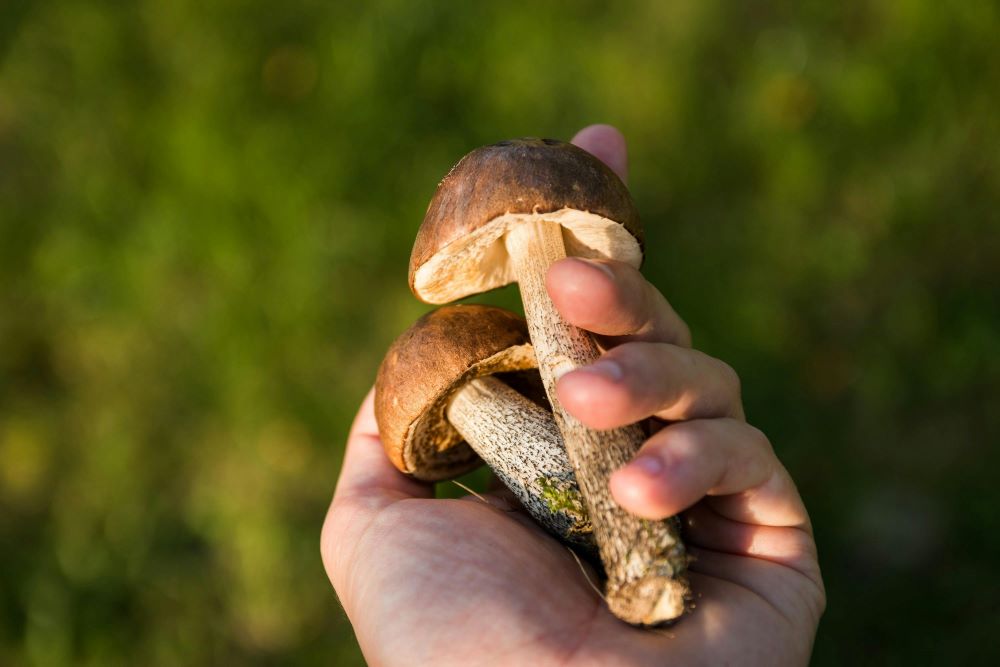
Creating the Perfect Environment for Mushroom Growth
08/07/24Share
Did you know that the delicious and nutritious mushrooms we all love eating are actually the fruiting bodies of a bigger and hidden fungus called mycelium? Mycelium exists beneath the surface of the soil, expanding its complex and extensive network of thread-like hyphae, absorbing nutrients from the soil and a variety of decaying organic matter. The resulting mushrooms only appear for a short period of time for one purpose – to reproduce by dispersing spores ensuring the continuation of the species.
But these mushrooms only appear when the conditions are perfect. Otherwise, they will remain dormant for years, waiting for suitable conditions. The good news is, you can recreate this condition on your own and have a steady supply of delicious mushrooms. Here’s how you can do it.
Why Grow Your Own Mushrooms?
Mushrooms are a versatile food ingredient that are both nutritious and delicious. They are a superb flavor enhancer that bring in a unique umami flavor that enhances the taste of dishes. They’re a great meat substitute for vegan and vegetarian dishes. Health-wise, they are low in calories and packed with antioxidants and anti-inflammatory properties that can help reduce chronic inflammation, as well as a long list of health conditions and diseases.
The good thing about growing mushrooms is that they can be grown all year-round and don't need much space. Depending on your setup and the climate in your area, they can be cultivated both indoors and outdoors.

Understanding the Life Cycle of the Mushroom
Before you start growing mushrooms, it is important that you have a good idea of how mushrooms actually grow and reproduce. Unlike fruits, where you plant seeds to grow, mushrooms start from spores. These spores germinate and develop into mycelium, which then develop the fruiting bodies (mushrooms) that we eat.
And as with other plants, different types of mushrooms require different conditions. This is why it is important to choose the type that matches both your environment and your skills. Some of the most common varieties of mushrooms are:
- Button mushrooms – a classic choice for beginners, grow in composted manure.
- Oyster mushrooms – good for complete beginners, can grow on various substrates.
- Lion’s Mane mushrooms – unique texture, grows on sawdust or hardwood.
- Shiitake mushrooms – for slightly more advanced, grow on hardwood.
Setting Up The Perfect Environment
The key to growing mushrooms is to set up a controlled environment where you can manage all the variables. Here’s a quick setup guide:
Find The Right Spot, Set Up The Spot
A controlled environment lets you manage all the variables and optimize the conditions to maximize mushroom growth. There are three basic things to consider; temperature, humidity, and light.
The first thing you need to do for that is to find the right space. This could be a greenhouse, a corner in your basement or garage, or even a spare closet. Then, insulate the area to maintain a consistent temperature. Depending on your area, you may need to use heaters, air conditioners, or a climate control system.
Lastly, set up the space with plenty of shelves or racks. This will allow you to maximize the space and allow proper air circulation. Depending on the type of mushroom you wish to grow, you may use trays, jars, or even bags as containers for your mushrooms.
On Humidity and Temperature Control
As you can see, most mushrooms thrive at around 80 to 95% humidity. You can track this using a hygrometer. You may also need a humidifier to maintain a certain level. Misting your mushroom growing space with water also works, but make sure you don’t overdo it.
In terms of temperature, it is another crucial factor to consider, as mushrooms are quite picky. This means you need a thermometer to monitor the temperature of your space. If your space is too hot, then invest in an air conditioning or at least a fan. If you live in a cold area, then you should get a heater for your mushrooms.
Light and Air Requirements
Unlike other plants, mushrooms don’t need light. Direct sunlight will actually harm them. But you still need some lighting in your space. They prefer no or low light, but indirect light or fluorescent bulbs will do since you may still need some lighting in your space.
Mushrooms need fresh air to grow. Thus, make sure there is proper ventilation in your area. You may also open the windows from time to time to allow some light and fresh air in.

The Substrate
The substrate is the material where the mushroom grows. The idea is to mimic the natural environment where mushrooms thrive. Different mushrooms require different substrates, but in most cases, you will need moist organic material for moisture.
Here’s a quick guide for the ideal temperature levels for different types of mushrooms and their preferred substrates:
- Button Mushroom: 85% to 90% humidity at 53-60°F (12-16°C), composted manure and straw for substrate.
- Oyster Mushrooms: 80-95% humidity, at 60-75°F (15-24°C), cardboard, coffee grounds and straw for substrate.
- Lion's Mane: 85-95%, at 65-75°F (18-24°C), hardwood and sawdust for substrate.
- Shiitake Mushrooms: 75-85% humidity, at 55-70°F (13-21°C), hardwood logs and sawdust for substrate.
- Maitake Mushrooms: 85-90% humidity, at 60-70°F (15-21°C), hardwood logs and sawdust for substrate.
- Enoki Mushrooms: 80-85% humidity, at 45-60°F (7-16°C), sawdust and hardwood for substrate.
- Reishi Mushrooms: 85-90% humidity, at 75-85°F (24-29°C), hardwood logs and sawdust for substrate.
- Portobello Mushrooms: 85-90% humidity, at 60-70°F (15-21°C), compost manure and straw for substrate.
- King Trumpet Mushrooms: 80-90% humidity, at 60-70°F (15-21°C), sawdust and straw for substrate.
- Morel Mushrooms: 85-90% humidity, at 55-60°F (13-16°C), decaying wood, leaf litter and compost for substrate.
- Chanterelle Mushrooms: 85-95% humidity, at 60-70°F (15-21°C), forest soil and moss for substrate.
- Cordyceps Mushrooms: 80-85% humidity, at 60-75°F (15-24°C), rice and silkworm pupae for substrate.
- Turkey Tail Mushrooms: 85-90% humidity, at 70-75°F (21-24°C), hardwood logs, sawdust for substrate.
Pasteurization
It is crucial to pasteurize the substrate to kill any unwanted bacteria or fungi. Different materials may require different pasteurization techniques. Here are some pasteurization techniques for various substrate materials:
Straw: soak in hot water (160-180°F) for 1-2 hours
Sawdust or wood chips: boil for 30 to 60 minutes.
Coffee grounds: boil for 30 minutes.
Cardboard: soak in hot water (160-180°F) for 1-2 hours
Manure-based compost: bake or steam at 160-170°F for 2-3 hours.
Hardwood logs: no pasteurization is needed; logs must be freshly cut and rested for at least two weeks.
Rice bran: boil or steam for 30 minutes.
Mixing The Spawn
The spawn is like the seeds for mushrooms. To mix the spawn, simply mix it into the pasteurized substrate and distribute evenly among the containers.
Setting Up The Containers for Incubation
Place the inoculated substrate (substrate mixed with spawn) into the containers. Make sure there is enough air exchange by making holes or slits in the containers.
Then, store the container in a dark and warm place. This will be the incubation period. Keep the temperature at 70-75°F (around 21 to 24°C.). Depending on the type of mushrooms you have, the mycelium will take a few weeks or even months to fully colonize the container.
Encourage Fruiting Conditions
Once the mycelium has fully colonized the substrate, you can now encourage the fruiting conditions for the mushrooms to show.
First, you need to drop the temperature by 5 to 10°F and increase the humidity to 90-95%. Mist multiple times a day (or via humidifier), allow light exposure (avoid direct sunlight) for 12 hours a day, and ensure good air exchange with good ventilation.
The Takeaway
As you can see, creating the perfect environment for mushroom growth is pretty easy and straightforward. Again, different types of mushrooms will have different requirements. Mushrooms grow at their own pace, so be patient. Start small with the easy ones, and adjust as needed. Before you know it, you’ll have a container full of mushrooms.
